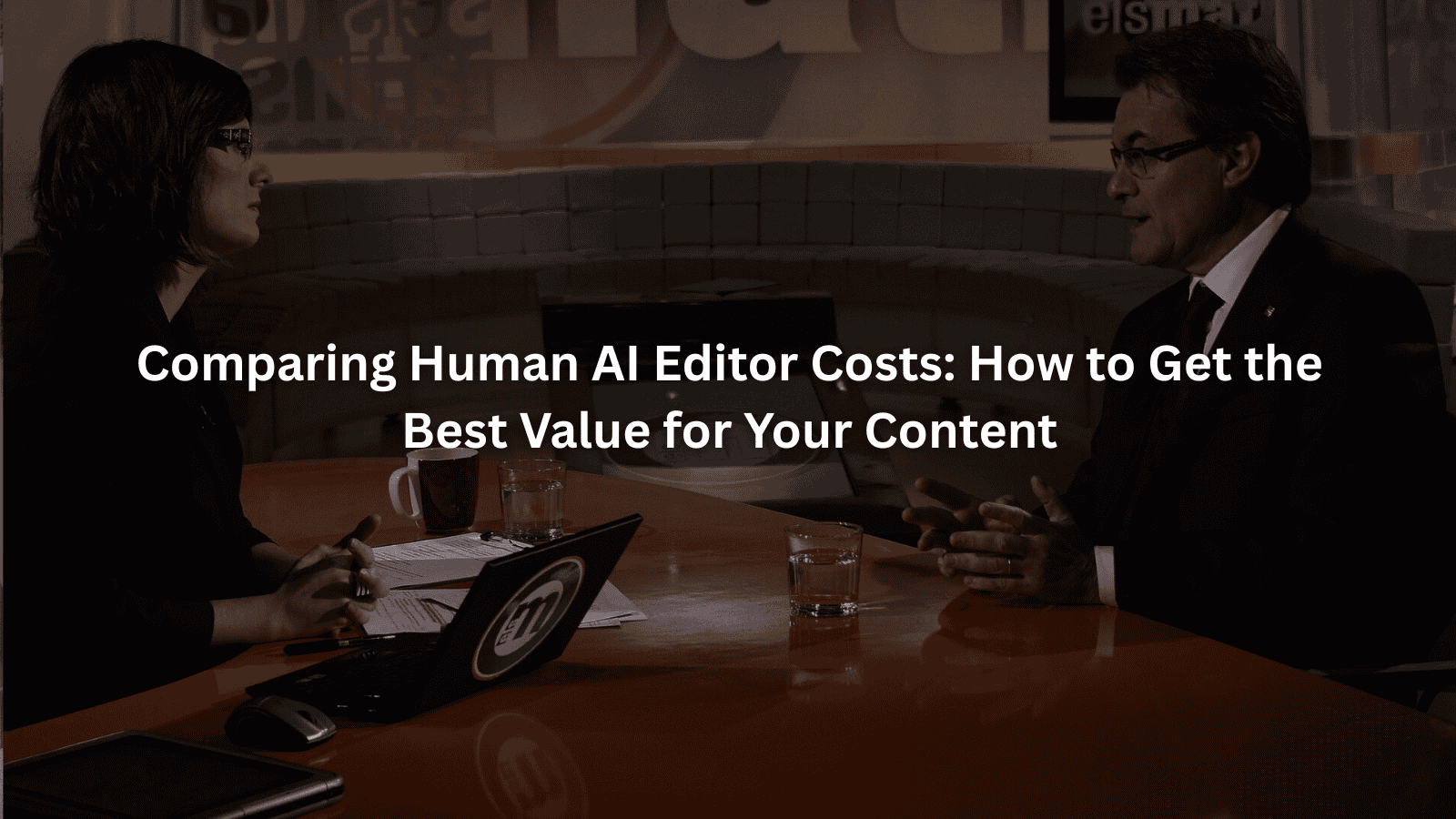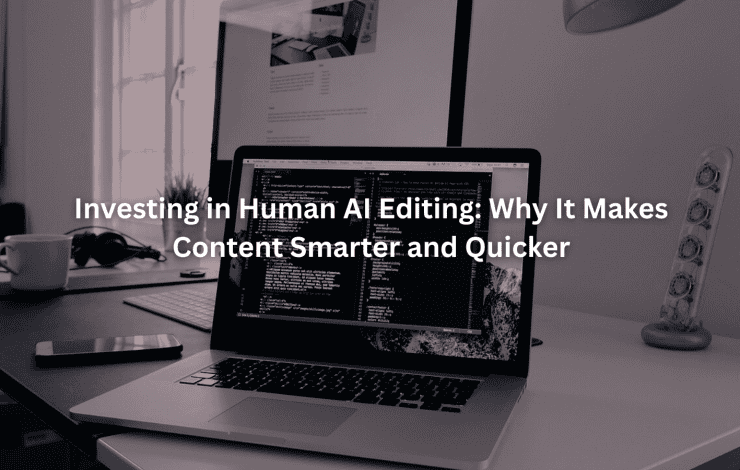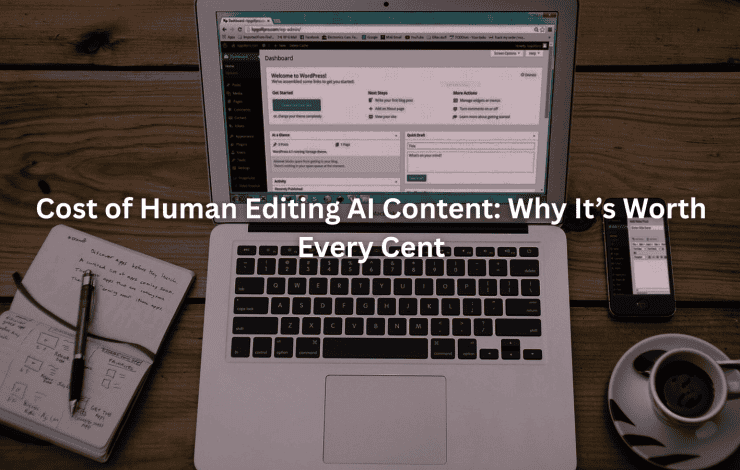Editing costs vary depending on who’s doing the work. Human editors want their money, charging anywhere from a few cents per word to a whopping hundred bucks an hour. Those AI tools though, they keep it simple with monthly subscriptions. Not too pricey.
But here’s the thing. Mix computers with real editors and something interesting happens. Good work, fair prices. At Jet Digital Pro we’ve watched clients wrestle with this balance for years. Quality costs money. Speed costs money. The trick is finding what works for your wallet.
Key Takeaway
- These editor services keep it flexible with pricing. Pay by word, hour, project, whatever works. Pretty straightforward stuff.
- Those AI tools alone? Cheap and fast, sure. But they miss the little things. Brand voice goes right over their heads.
- Mix humans and AI together though, now you’re talking. Gets the job done faster, better, cheaper. Most folks save about 20 to 40 percent compared to pure human editing. Worth thinking about.
Human AI Editor Cost Structures and Pricing Models
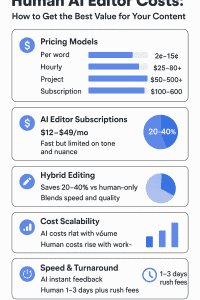
Human AI Editor Services and Pricing Models
We’ve seen pretty much everything at Jet Digital Pro when it comes to pricing these services. Some folks just want to pay by the word, makes sense really. Others need more time, more back and forth, so hourly rates work better there. And then there’s the big stuff, like entire books or major reports where project fees just make more sense.
Numbers get real simple real quick. Start with pennies per word, maybe 2 cents if you’re lucky. Top end hits about 15 cents when you need the fancy stuff. Makes sense. Hourly work’s where things get interesting though. Some folks charge 25 bucks, others want 80. Depends who you’re dealing with. Big projects? That’s different math. Could be 50 dollars, could be way over 500. Just depends.
Monthly deals work too. Companies dig that setup. Pay anywhere from 100 to 600 a month, get your stuff edited whenever. Pretty sweet deal if you ask me. But listen, here’s what matters: everything’s gotta be crystal clear upfront. Hidden fees? Nobody’s got time for that. Good business means knowing exactly what you’re paying for, and understanding the real pricing and ROI of human AI content editors before you commit.
Per Word Pricing for Human AI Editor Services
Simple math here. Got a thousand word blog post? Expect to pay between 20 and 150 bucks. Clean and easy. Pay for what you need, nothing more. Works great for those one off jobs or when you’re not sure how long something’s gonna be. Our clients like knowing exactly what they’re in for before they start.
Hourly Rates for Human AI Editor Services
Money talks, right? When you need someone to really get in there and fix things up, hourly’s the way to go. Good editors aren’t cheap, running anywhere from 25 to 80 per hour. Depends how deep they gotta dig. At Jet Digital Pro, we throw some AI in the mix, keeps things moving without killing your wallet. Perfect when you need to bounce ideas back and forth.
Project-Based Pricing for Human AI Editor Services
Sometimes you just want one price for the whole thing. Makes sense for stuff like cleaning up an ebook or fixing up content for different markets. Expect to pay between 50 and 500 dollars, give or take. Size matters. Complexity too. We like keeping it simple at Jet Digital Pro. One price, no surprises. Works better for everyone’s blood pressure.
Subscription Plans for Human AI Editor Services
Monthly plans make life easier for the busy folks. Marketing teams love ’em. Pay somewhere between 100 and 600 bucks each month, get your words edited without the hassle. First in line too, usually. Nice way to keep the content machine running without breaking the bank. We’ve seen it work wonders for companies trying to grow their content game without going crazy.
Human-Only Editor Cost Ranges and Rates
Human editors remain essential for nuanced, high-quality content. Freelancers and professionals charge anywhere from $30 to $100 per hour, influenced by experience and specialization. In-house editors add salaries plus benefits and overhead, making total costs much higher. Clients sometimes overlook these hidden expenses. At Jet Digital Pro, we combine AI tools with human editors to reduce these burdens while maintaining quality.
This reflects what CMSWire noted about AI in 2025, automation handles the repetitive tasks, but true brand building still relies on human creativity and judgment. [ 1 ]
Hourly Rates Variation by Experience Level
Junior editors might charge around $30 an hour, while experts demand $75 to $100 or more. Specialized editors handling legal or technical content command premium rates. This range reflects skills and the nature of the work involved.
Additional Overhead and Training Costs for Human Editors
Employers bear costs beyond wages: recruiting, training, software, workspace, and quality checks. These overheads inflate editing costs by 20 to 50 percent. Scaling up amplifies these expenses quickly, making human-only editing costly for large projects.
AI-Only Editor Software Cost Ranges
AI editing tools mostly use subscription pricing, usually from free tiers up to about $50 per month. These tools automate grammar, punctuation, and style fixes quickly and handle large volumes without increasing costs per word or hour.
The low price is appealing, especially for high-volume content. But AI has limitations: it lacks understanding of tone, brand voice, and context. At Jet Digital Pro, we treat AI as a first pass, useful but not enough alone. Forbes points out that autonomous AI agents are now driving measurable ROI in business, proving just how scalable and efficient they can be, though still not a full replacement for human oversight. [ 2 ]
Monthly Subscription Fees for AI Editing Tools
Most AI editors charge between $12 and $49 monthly. Free plans often limit word counts or features, while paid subscriptions offer more thorough checks and faster processing. For businesses producing lots of content, a higher-tier plan usually offers better value by removing caps and speeding workflow.
Limitations of AI-Only Editor Pricing
While AI editors save money upfront, they may cause extra costs down the line if human fixes are needed. AI struggles with complex language, tone, and context, often requiring manual intervention. This can offset initial savings and affect content quality.
Hybrid AI + Human Editor Pricing and Value Propositions
Hybrid editing blends AI’s speed with human judgment. AI handles mechanical corrections fast, while humans review tone, context, and brand voice. This often cuts costs by 20 to 40 percent compared to human-only editing.
Clients value quicker turnarounds and consistent quality. At Jet Digital Pro, we’ve refined this method to deliver content that looks human and passes AI detection tests. For many businesses, the real payoff comes down to the ROI of hiring a human AI editor, since it balances cost and quality better than either option alone.
Cost Efficiency Compared to Human-Only Editing
Automating routine fixes reduces human hours per project. For example, an edit taking two hours human-only might need only one hour of human review after AI pre-processing, lowering costs.
Quality and Turnaround Advantages of Hybrid Models
Hybrid workflows speed delivery without losing nuance. AI flags obvious errors instantly, freeing human editors to focus on complex issues. This balance suits tight deadlines and high standards.
Cost Efficiency and Scalability in Editing Services

Cost Efficiency Metrics of AI Editors
AI editing’s got a neat trick up its sleeve. Once you’ve paid that monthly fee, it doesn’t matter if you’re fixing up a short blog post or an entire book. Same price. Pretty sweet deal for anyone churning out loads of content. Publishers love this stuff. Marketing agencies too. No more sweating about costs when deadlines pile up.
Over at Jet Digital Pro, we watch clients breathe easier knowing their editing bills won’t suddenly explode. These computer editors just keep going, day and night. No coffee breaks needed. For companies drowning in content, that’s money in the bank.
Marginal Costs of Large-Volume AI Editing
Here’s where it gets interesting. Dump more work on AI, the price barely budges. But human editors? They need paying for every extra page. Fifty bucks an hour adds up fast. Double the work, double the cost. Simple math.
Those zeros matter. Companies pushing out thousands of product descriptions or cranking out blog posts daily, they get it. We’ve seen it at Jet Digital Pro. AI just chomps through massive files, keeping quality steady without emptying anybody’s wallet.
Subscription Tier Effects on Cost Scalability
These AI companies know what they’re doing with their pricing tiers. Spend more, get more bells and whistles. Grammar stuff, style suggestions, unlimited words. Some folks look at that 49 dollar unlimited plan and figure it beats paying overage fees any day.
Smart business means matching what you need to what you spend. At Jet Digital Pro, we tell it straight. Look at your monthly numbers before jumping into any plan. Nobody wants surprise bills when content demands suddenly jump.
Cost Considerations for Human Editors
Now human editors, that’s different math altogether. More pages equals more money, period. Not like AI’s flat rate deal. And it ain’t just hourly rates eating up budgets. People quit. New hires need training. Everything costs something.
Money just disappears sometimes. We see it at Jet Digital Pro. Lose an editor? Better plan on weeks getting the new person up to speed. That’s real dollars walking out the door. Makes it tough to plan ahead, especially when work comes in waves. And waves always come.
Operational Costs Including Overhead and Turnover
Operating a human editing team involves more than salaries. Recruiting new editors takes time and money, and training reduces productivity temporarily. Turnover disrupts workflows and requires ongoing investment to maintain quality. These overheads add 20 to 50 percent on top of base wages, inflating the true cost per edited word or hour.
Many companies overlook these hidden costs when budgeting for human editing. At Jet Digital Pro, we account for these factors when planning scalable editing solutions. Acknowledging overhead helps clients better understand their total investment and make smarter choices about resource allocation.
Impact of Rush Fees and Editing Speed on Cost
When deadlines tighten, human editors often charge rush fees or overtime rates, sometimes doubling or tripling hourly prices. These premiums compensate for working nights, weekends, or rearranging schedules. Rush jobs can strain budgets significantly, especially for last-minute content needs.
At Jet Digital Pro, we’ve seen clients get caught off guard by these surcharges. This unpredictability makes planning critical; early scheduling avoids extra costs. In contrast, AI editing provides instant turnaround with no rush fees, offering better control over expenses when speed matters.
Comparative Cost Savings of Hybrid Editing Approaches
Hybrid editing blends AI’s speed with human judgment, cutting down the hours humans spend on each piece. This combination typically saves clients 20 to 40 percent compared to relying solely on human editors. AI tools handle routine corrections fast, while human editors focus on nuance and quality control.
This workflow speeds delivery and reduces the chance of costly rush fees. From our experience at Jet Digital Pro, hybrid models offer a practical balance of cost savings and high editorial standards. Clients appreciate that they don’t have to sacrifice quality to stay within budget, making hybrid editing an attractive option for many projects.
Percentage Cost Reduction Relative to Human-Only Editing
Clients using hybrid editing usually save about one-third of their editing costs compared to human-only workflows. This reduction results from fewer billable human hours per project since AI pre-cleans drafts efficiently.
At Jet Digital Pro, this model lets us offer competitive pricing without cutting corners. The savings often allow clients to reallocate budget to other priorities like content creation or marketing. Hybrid editing proves that you don’t have to choose between cost and quality , smart workflows make both possible.
Balancing Cost and Quality in Hybrid Services
At Jet Digital Pro, we emphasize that cost savings shouldn’t mean sacrificing quality. After AI finishes the initial pass, human editors perform thorough checks to catch errors AI might miss. This combination maintains high editorial standards while controlling expenses.
The hybrid approach also allows faster turnaround times, meeting tight deadlines without rushing the human review. Balancing cost and quality this way helps clients get polished, brand-aligned content without overspending.
Hidden and Recurring Costs in Editing Services
Both human and AI editing involve ongoing costs beyond the advertised fees. Human editors require regular training to stay updated on style guides and client preferences. Quality assurance teams perform spot checks, adding labor costs.
AI tools need constant maintenance, software updates, and sometimes human oversight to catch errors the machine misses. These recurring expenses impact budgets but often go unnoticed. At Jet Digital Pro, we manage these hidden costs carefully to keep pricing transparent and services reliable.
Human Editor Training and Quality Assurance Expenses
Regular training ensures human editors understand evolving style guides, brand voice, and industry standards. It also refreshes their skills on grammar and formatting. Quality assurance teams audit edited content for consistency and accuracy.
These activities require staff time and resources, increasing operational costs. At Jet Digital Pro, investing in training and quality control protects clients from mistakes and maintains editorial excellence, but these expenses contribute to the true cost of human editing services.
AI Tool Maintenance and Human Oversight Requirements
AI editing software demands continual updates to improve accuracy, fix bugs, and adapt to language changes. Providers often release new versions regularly, requiring monitoring and testing. Additionally, humans must oversee AI output to catch subtle errors or context issues that machines miss.
This oversight involves editors reviewing and correcting AI’s suggestions, adding labor costs. At Jet Digital Pro, combining AI with human review ensures reliability but means budgeting for these hidden maintenance and supervision costs.
Quality, Scope, and Editing Accuracy Considerations
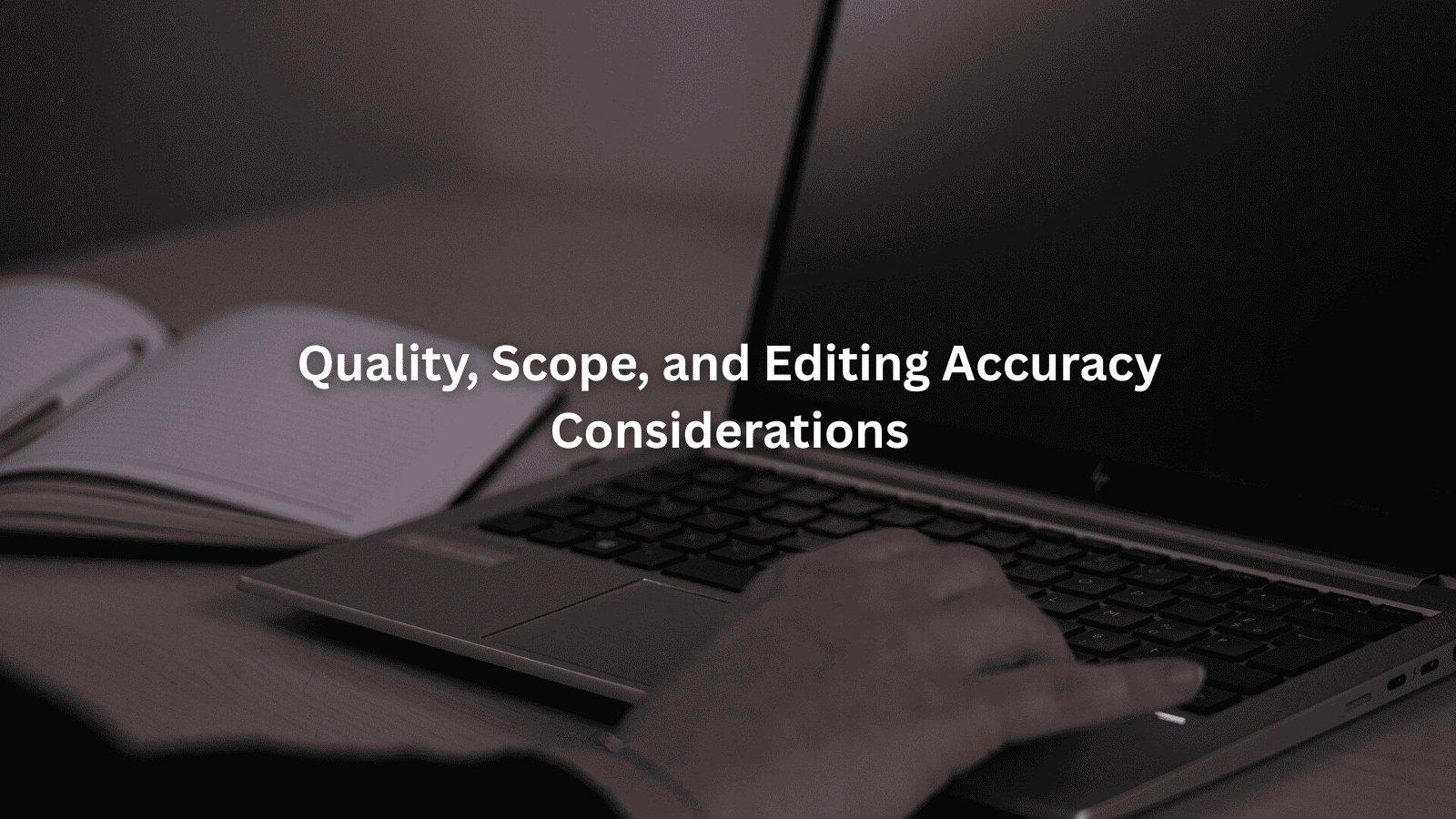
Quality Differences Between Human and AI Editors
Humans excel at picking up nuances that AI often misses. We’ve seen editors catch subtle shifts in tone, cultural references, and brand-specific language that machines don’t recognize. For example, a phrase that sounds fine grammatically might feel off-brand or awkward, and a human editor spots that easily.
AI shines at fast, consistent mechanical corrections like fixing grammar, punctuation, or spelling errors. It’s reliable for obvious mistakes but cannot grasp the deeper meaning or emotional undertones in a text. At Jet Digital Pro, we use AI to handle the mechanical side quickly, freeing human editors to focus on these subtleties.
This combined approach ensures content stays polished and true to the intended voice, which is essential for meaningful communication.
Human Editors’ Strengths in Nuanced Content and Brand Voice
Experienced human editors adapt to client preferences by adjusting tone and style to fit the brand’s personality. They can spot awkward phrasing that disrupts flow or logical gaps that confuse readers. For instance, marketing copy needs to connect emotionally with the audience; human editors know how to tweak words for impact.
They understand context, idiomatic expressions, and cultural cues, things AI can’t yet interpret well. At Jet Digital Pro, our editors build relationships with clients to learn these nuances deeply, maintaining consistency and ensuring every piece feels intentional and polished.
AI Editors’ Strengths in Mechanical Error Detection
AI excels at quickly scanning text for common errors like spelling mistakes, grammar slips, and punctuation problems. It works tirelessly and consistently, catching issues that might be overlooked during long editing sessions. This makes AI a great first filter, cleaning up the bulk of mechanical errors before a human even looks at the draft.
AI tools can also enforce formatting standards uniformly across documents, which is helpful for large volumes of content. While AI can’t judge tone or style, its mechanical accuracy speeds up the editing process and reduces human workload, allowing editors to focus on higher-level improvements.
Scope of Editing Tasks Suited for Human vs AI Editors
AI editing fits well for routine tasks like proofreading, grammar checks, and spelling corrections where the rules are clear and objective. It handles straightforward fixes efficiently, making it ideal for bulk content that doesn’t require deep understanding.
However, complex content that needs interpretation, creativity, or critical thinking calls for human editors. Such tasks involve reworking sentences, improving flow, or tailoring messages to specific audiences. At Jet Digital Pro, we recommend human editing for content that demands emotional resonance, strategic messaging, or brand alignment.
High-Stakes Content Requiring Human Editing Expertise
Books, academic papers, marketing materials, and legal documents are examples where human judgment is crucial. Errors in these types of content can harm credibility or even cause legal issues.
Human editors ensure the accuracy of facts, the logical consistency of arguments, and appropriate tone throughout. For instance, a legal document requires precise language and no ambiguity, something AI can’t reliably guarantee. We’ve found that clients producing such material benefit greatly from experienced editors who understand the stakes and nuances involved.
Routine Content Suitable for AI Editing Automation
Routine content like news briefs, social media posts, and product descriptions can be efficiently handled by AI. These types of writing usually follow standard structures and simple language, making them perfect candidates for automated proofreading and corrections.
Are You a Digital Agency?
White Label SEO Content Services for Agencies
Scalable, customizable, and results-driven content solutions for your clients.
Using AI for such content saves time and costs, freeing human editors to focus on more demanding projects. At Jet Digital Pro, we often suggest clients use AI editing for high-volume, low-complexity work to improve efficiency without compromising basic accuracy.
Editing Accuracy and Human Touch Versus AI Limitations
Humans excel at catching inconsistencies in context, tone mismatches, and emotional subtleties that AI often overlooks. For example, sarcasm, humor, and idiomatic expressions can confuse AI, leading it to suggest incorrect changes.
Humans understand the layered meanings behind words and can judge if a sentence fits the author’s intent. This accuracy is especially important in marketing or narrative writing where emotional connection matters. Jet Digital Pro relies on human editors to ensure content reads naturally and resonates with readers.
Human Accuracy in Contextual and Logical Consistency
Human editors check that facts line up, arguments flow logically, and that the content makes sense as a whole. This is especially critical in technical or academic writing where errors can mislead readers or damage credibility. Humans also catch contradictions or unclear phrasing that machines might miss. We’ve seen editors at Jet Digital Pro improve entire documents by reorganizing paragraphs and clarifying points, tasks beyond AI’s current capabilities.
AI Limitations in Tone, Emotion, and Complex Language
AI struggles to interpret tone, emotional nuance, and complex language. It can’t detect sarcasm or irony and may suggest changes that alter the writer’s intended meaning. For example, AI might flag a perfectly valid idiom as an error or recommend formal wording for informal content. These limitations mean AI alone isn’t suitable for content where personality and voice matter. At Jet Digital Pro, we use AI as a tool but rely on human editors to preserve these finer points.
Editorial Consistency and Brand Knowledge Impacts
Human editors develop a deep understanding of a brand’s voice and style over time, ensuring consistent messaging across all content. This familiarity helps maintain the tone, terminology, and values that define a company’s identity.
AI tools lack this memory and personalization, often applying generic corrections that may clash with brand personality. Jet Digital Pro invests in training editors to internalize client preferences and create style guides that keep content aligned with brand goals.
Human Editor Reliability in Maintaining Brand Voice
At Jet Digital Pro, our editors build detailed style guides and notes for each client, capturing preferences on tone, word choice, and formatting. They apply this knowledge consistently, ensuring every piece supports brand integrity. This human reliability is critical for businesses wanting to build trust and recognition through their content.
AI Editing Tool Constraints on Content Personalization
AI editing tools apply standard rules and patterns without context. They can’t tailor suggestions to a specific brand’s voice or audience. This can lead to corrections that feel generic, stiff, or out of sync with the desired style. While AI is excellent for mechanical accuracy, it falls short on personalization, which is why human oversight remains necessary for quality content.
Speed, Turnaround, and Practical Editing Solutions
Speed and Turnaround Times for AI Editors
AI editing tools deliver feedback almost instantly. Uploading a draft will often return corrections in seconds, allowing writers and editors to make quick fixes and keep projects moving. This speed is a huge advantage when deadlines are tight or content volume is high. For businesses producing daily blog posts, product descriptions, or social media content, AI editors can keep pace without delay.
The technology scales well, meaning that increasing the number of words or documents edited doesn’t slow turnaround. You don’t have to worry about bottlenecks or waiting in line. While AI can’t replace every human touch, its ability to provide near-instant results makes it invaluable for fast content cycles. At Jet Digital Pro, we’ve seen how this speed frees up human editors to focus on more complex issues.
Instant or Near-Instant AI Editing Feedback
The immediate feedback from AI tools lets teams catch grammar and punctuation issues right away. This cuts down on back-and-forth emails or waiting for human reviews and helps keep content schedules on track.
Scalability Benefits for Fast Content Production
Because AI doesn’t tire or slow down, you can increase your content output without worrying about editing delays. This scalability suits agencies and businesses pushing volume regularly.
Human Editing Turnaround and Cost Implications
Human editing takes longer, usually ranging from a day to several days depending on workload and assignment complexity. Editors juggle multiple projects and need time to review content thoroughly, especially when tone, style, and context matter. When deadlines loom, clients often request rush services, which can double or even triple hourly rates.
These expedited fees reflect the pressure on editors to prioritize assignments and work outside normal hours. At Jet Digital Pro, we’ve noticed that while human editors deliver precision and nuance, turnaround time often becomes a trade-off with cost. Planning ahead helps avoid rush charges, but if speed is critical, hybrid models or AI-only edits can offer more budget-friendly options.
Typical Timeframes for Human Editing Assignments & Cost Increase Due to Rush or Expedited Editing
Most human editing projects complete within 24 to 72 hours. Complex or lengthy work, like technical reports or creative manuscripts, may take longer depending on editor availability.
When you need content fast, expect higher fees. Rush jobs require editors to shift schedules or add overtime, increasing expenses and impacting budgets.
Hybrid Editing Workflow for Balanced Speed and Quality
Need a Strategic SEO Content Partner?
Let’s craft SEO content that ranks, converts, and grows your brand.
Talk to UsNobody wants to wait forever for perfect copy. That’s where mixing machines and people makes sense. Let computers catch the obvious stuff first. Then real editors jump in, making sure everything flows right and sounds like your brand. We’ve been doing this at Jet Digital Pro for a while now. Works pretty well.
Editors spend less time hunting down typos, more time making things sound good. Perfect for clients who need quality but can’t wait around forever. Marketing agencies love it. Keeps projects moving without turning into a mess.
Initial AI Drafting Followed by Human Refinement & Optimizing Turnaround Time and Quality Control
Computers do the heavy lifting first. Find those basic mistakes. Then people step in. They get what you’re trying to say, make it sound natural. Like actual humans wrote it.
Set your deadlines. Let AI handle the crush when things get busy. Real editors keep an eye on everything, make sure it all looks right before it goes out the door.
Editing Service Selection Based on Content Needs
Look, picking the right editing service isn’t rocket science. Think about what you’re writing, what you can spend, and when you need it done. Got tons of product descriptions or social posts? AI’s probably fine. Working on something that needs to grab people, like marketing stuff or fancy white papers? Better get some human eyes on that.
Mix both when you can. Gets things done faster without losing that human touch. At Jet Digital Pro, we guide clients to think hard about who’s gonna read their stuff, and often suggest an affordable human AI editor service when budgets are tight but quality still matters.
Choosing AI Editing for Volume and Speed Priorities & Selecting Human or Hybrid Editing for Depth and Nuance
Need to push out lots of content fast without breaking the bank? AI’s got your back. Handles the basic stuff just fine. But when the message really matters, when you need to nail the tone just right? That’s when you want people involved. AI just can’t catch the subtle stuff yet.
FAQ
How do hidden expenses affect the real cost of human versus AI editing services?
When comparing costs, many overlook hidden expenses like training, recruitment, and quality control for human editors. These add to the hourly or project rates significantly. AI tools have lower upfront costs but require ongoing maintenance and occasional human oversight. Understanding these hidden fees helps get a clearer picture of the true price beyond advertised rates.
Can subscription plans for human AI editors really save money for small businesses?
Subscription plans often seem designed for agencies, but small businesses can benefit too. Paying a monthly fee can lock in consistent editing support at a fixed cost, which helps budget forecasting. However, if editing needs are sporadic, subscriptions might cost more than pay-as-you-go models. It depends on your content volume and how steady your editing demands are.
Why might hybrid human-AI editing cost less than pure human editing despite involving both?
You’d think having both AI and humans would cost more, but hybrid editing often cuts expenses. AI handles repetitive, mechanical tasks quickly, reducing the time human editors spend on each piece. This efficiency lowers hourly charges and speeds turnaround, making the total cost less than relying solely on human editors who do everything manually.
What impact does editing turnaround time have on the pricing differences between human and AI editors?
Faster turnaround usually means higher costs for human editors because they may charge rush fees or overtime rates. AI editing, with instant feedback, avoids these extra charges. When tight deadlines matter, AI or hybrid services often offer better cost control. It’s important to factor in how quickly you need content edited when comparing prices.
How does the scale of content production influence the cost benefits of AI versus human editing?
For small batches, human editors might be more cost-effective because of personal attention. But as content volume grows, AI’s near-zero marginal cost per additional word becomes a big advantage. Large-scale projects with thousands of words see AI tools scaling without rising fees, while human editing costs climb steadily with volume. Hybrid models help balance scale and quality.
Conclusion
At Jet Digital Pro, we’ve seen how blending AI efficiency with expert human editing creates the perfect balance of speed, cost, and quality. Our 11-step editing process ensures content isn’t just fast, it’s polished, Google-ready, and built to scale for agencies managing multiple projects under tight budgets. This mix helps agencies grow their SEO services without the extra workload.
Get in touch with Jet Digital Pro today to scale smarter.
References
- https://www.cmswire.com/digital-marketing/ai-in-marketing-in-2025-smart-automation-and-brave-brand-building
- https://www.forbes.com/sites/jaimecatmull/2025/03/27/5-ways-ai-agents-can-generate-roi–no-human-needed
Related Articles
- https://jetdigitalpro.com/pricing-roi-for-human-ai-content-editors
- https://jetdigitalpro.com/roi-of-hiring-human-ai-editor
- https://jetdigitalpro.com/affordable-human-ai-editor-service
P.S – Whenever you’re ready,
we’re here to help elevate your SEO content.
Partner with us for strategic, scalable content that drives real organic growth.
Contact Us Now
